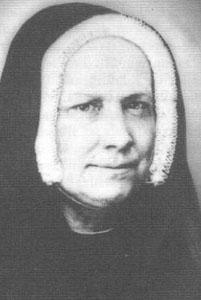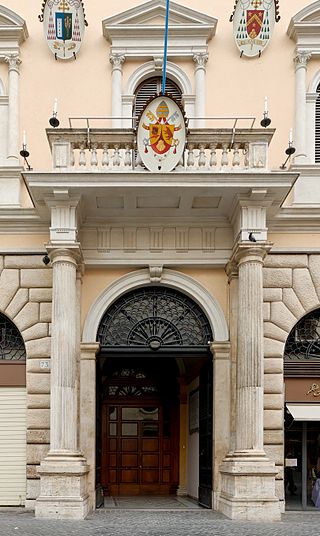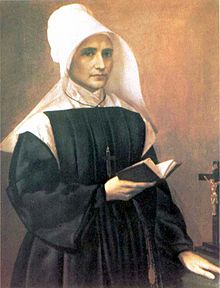
Elizabeth Ann Bayley Seton was a Catholic religious sister in the United States and an educator, known as a founder of the country's parochial school system. After her death, she became the first person born in what would become the United States to be canonized by the Catholic Church. She also established the first Catholic girls' school in the nation in Emmitsburg, Maryland, where she likewise founded the first American congregation of religious sisters, the Sisters of Charity.

The Camaldolese Hermits of Mount Corona, commonly called Camaldolese, is a monastic order of Pontifical Right for men founded by Saint Romuald. Its name is derived from the Holy Hermitage of Camaldoli, high in the mountains of central Italy, near the city of Arezzo. Its members add the nominal letters E.C.M.C. after their names to indicate their membership in the congregation. Apart from the Roman Catholic monasteries, in recent times ecumenical Christian hermitages with a Camaldolese spirituality have arisen as well.

The Trinitarians, formally known as the Order of the Most Holy Trinity and of the Captives, is a mendicant order of the Catholic Church for men founded in Cerfroid, outside Paris, in the late 12th century. From the very outset, a special dedication to the mystery of the Holy Trinity has been a constitutive element of the order's life.
The Daughters of the Cross of Liège are religious sisters in the Catholic Church who are members of a religious congregation founded in 1833 by Marie Thérèse Haze (1782–1876). The organization's original mission is focused on caring for the needs of their society through education and nursing care.

James Alberione, SSP, was an Italian Catholic priest, and the founder of the Society of St. Paul, of the Daughters of St. Paul, of the Pious Disciples of the Divine Master, of the Sisters of Jesus the Good Shepherd, of the Sisters of Mary Queen of the Apostles, and other religious institutes, which form the Pauline Family. The first two groups are best known for promoting the Catholic faith through various forms of modern media.

Joseph Cafasso was an Italian Catholic priest who was a significant social reformer in Turin. He was one of the so-called "Social Saints" who emerged during that particular era. He is known as the "Priest of the Gallows" due to his extensive work with those prisoners who were condemned to death. But he was also known for his excessive mortifications despite his frail constitution: he neglected certain foods and conditions to remain as frugal and basic as possible unless a doctor ordered otherwise.
The Third Order of Saint Francis is a third order in the Franciscan tradition of Christianity, founded by the medieval Italian Catholic friar Francis of Assisi.
The Dominican Sisters of Mary, Mother of the Eucharist, is a Catholic female religious institute of diocesan right, rather than Pontifical right, based in Ann Arbor, Michigan which follows the charism of the Dominican Order. The congregation was founded in 1997 by four members of the Dominican Sisters of St. Cecilia in Nashville, Tennessee. As of 2021, it has 155 members.

Magdalena di Canossa was an Italian professed religious and foundress of the two Canossian congregations. Magdalena was a leading advocate for the poor in her region after she witnessed first hand the plight of the poor following the spillover effects of the French Revolution into the Italian peninsula through the Napoleonic invasion of the northern territories. Canossa collaborated with humanitarians such as Leopoldina Naudet and Antonio Rosmini in her mission of promoting the needs of the poor and setting a new method of religious life for both men and women.

Maria Matilda De Mattias was an Italian woman who founded the religious congregation of the Sisters Adorers of the Blood of Christ. She is a saint in the Catholic Church, having been canonized by Pope John Paul II in 2003.

Paula Frassinetti is an Italian saint in the Roman Catholic Church and foundress of the Congregation of the Sisters of Saint Dorothy. Her feast day is June 11.

The Roman Colleges, also referred to as the Pontifical Colleges in Rome, are institutions established and maintained in Rome for the education of future ecclesiastics of the Catholic Church. Traditionally many were for students of a particular nationality. The colleges are halls of residence in which the students follow the usual seminary exercises of piety, study in private, and review the subjects treated in class. In some colleges there are special courses of instruction but the regular courses in philosophy and theology are given in a few large central institutions, such as Pontifical Urbaniana University, the Pontifical Gregorian University, the Pontifical Lateran University, and the Pontifical University of Saint Thomas Aquinas, Angelicum.
The Sisters of St. Anne (S.S.A.) is a Roman Catholic religious institute, founded in 1850 in Vaudreuil, Quebec, Canada, by the Blessed Marie Anne Blondin, S.S.A., to promote the education of the rural children of the Province of Canada. Their vision is rooted and guided by Ignatian spirituality.
Sisters of Providence may refer to a number of congregations of Religious Sisters:
The Missionary Sisters of the Immaculate Conception of the Mother of God are an institute of religious sisters in the Roman Catholic Church. The congregation belongs to the Third Order Regular of St. Francis. They were founded in 1910 in Santarém, Brazil, by Armand August Bahlmann, OFM, and Mother Immaculata, both natives of Germany, to educate the children of the poor throughout the world.

Caterina Dominici was an Italian Roman Catholic nun who took the name of Maria Enrichetta after she became a nun of the Sisters of Saint Anne. During the 1854 Broad Street cholera outbreak she cared for and ministered to countless people. She then went on to serve for over three decades as the Superior General of her congregation. She was also a friend and adviser to John Bosco.
Marcantonio Durando was an Italian Roman Catholic priest and a professed member of the Congregation of the Mission in an effort to follow the teachings of Vincent de Paul - an ardent focus of his life and pastoral career. Durano was also the founder of the Daughters of the Passion of Jesus the Nazorean (1865) - or Nazarene Sisters - and founded that order with the assistance of Luigia Borgiotti (1802-1873).

Juliette Colbert Falletti de Barolo - born as Juliette Victoire Colbert and known in Italy as Giulia Falletti di Barolo - was a French Roman Catholic philanthropist and the founder of both the Sisters of Saint Anne and the Daughters of Jesus the Good Shepherd. Colbert was a well-educated girl living in France during and after the tumultuous French Revolution which caused her faith to deepen since she had the desire to aid the poor and neglected. Her marriage to a nobleman in Paris led to the two setting off to live in Turin where the couple threw themselves into charitable works. The couple bore no children but rather "adopted" the town's poor. Colbert was widowed some decades later and became professed into the Secular Franciscan Order while establishing hospitals and schools as well as other charitable institutions.
Adolfo Barberis was an Italian Roman Catholic priest and the founder of the Sisters of Christian Servanthood. Barberis served as the assistant to the Archbishop of Turin from 1906 until the cardinal's death in 1923 at which point he worked for sometime as a professor. He did this while managing the functions of the religious congregation he established which he had dedicated to the education and care of women in domestic service. The consequences of World War I were enough to convince him to found an order to help women though he often faced difficulties in dealing with Cardinal Maurilio Fossati in the beginning of the latter's tenure as Archbishop of Turin. These disagreements came due to Fossati's limited knowledge of Barberis' work and the slander levelled against him sometime before that. This slander came in 1923 after his cardinal benefactor died as some fellow priests suggested he garnered too much power in his position.

Carlo Tancredi Falletti di Barolo was an Italian Roman Catholic noble who, with his wife Juliette Colbert, co-founded the Sisters of Saint Anne. Born and raised in Turin, Falletti came from a long line of nobles originally from France. He was admitted into the court of Napoleon Bonaparte where he would meet his future wife whom he married in 1806; he became a count in 1810 and relocated in 1814 to Turin with his wife where he became part of the local council and helped in infrastructure and educational developments.












